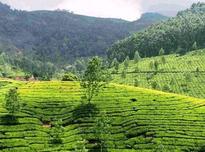Ceylon Tea
|
The tea sector in Sri Lanka has always been a vital component of her economy. It is also the largest employer providing employment both directly and indirectly to over one million people of Sri Lanka. It also contributes a significant amount to Government revenue and to the gross domestic product.
Ceylon tea from Sri Lanka, acclaimed as the best in the world, has its inherent unique characteristics and reputation running through more than a century. The influence of climatic conditions of its plantation imparts to the product a variety of flavors and aromas, synonymous with quality. Sri lanka, as the 3rd biggest producer globally, has a production share of 9% in the international sphere, and one of the world's leading exporters with a share of around 19% of the global demand. The total extent of land under cultivation has been assessed at approximately 187,309 hectares. Sri Lanka produces throughout the year and the growing areas are mainly concentrated in the central highlands and southern inland areas of the island. They are broadly grouped under these headings according to their elevations, with high growns ranging from 1200 m upwards, medium growns covering between 600 m to 1200 m. and low growns from sea level up to 600 m. High growns from Sri Lanka are reputed for their taste and aroma. The two types of seasonals produced in these areas, Dimbula and Nuwara Eliya, are much sought after by blenders in importing countries. Uva produce from Eastern Highlands of Sri Lanka contain unique seasonal characters and are widely used in many quality blends particular in West Germany and Japan. The medium growns of Sri Lanka provide a thick coloury variety which are popular in Australia, Europe, Japan and North America. The low growns of Sri Lanka are mainly popular in Western Asia, Middle Eastern countries and CIS countries. Most factories in these areas produced what are known as leafy grade of tea where the leaves are well twisted and can grade into long particles. Sri Lanka mainly produces orthodox teas. In the orthodox process of production, semi dried green shoots are ruptured by rolling achieved from a rotary movement. The rolling process ruptures and twists the leaves. When tea leaves are crushed an oxidation process begins, which is followed by firing and commonly known black tea is produced. Sri Lanka also produces using unorthodox method, namely Cut Tear and Curl (C.T.C). Green, Instant, Bio, and flavored. Source: Sri Lanka Tea Board |
"Teascapes" courtsey www.nuwaraeliyaonline.com |






